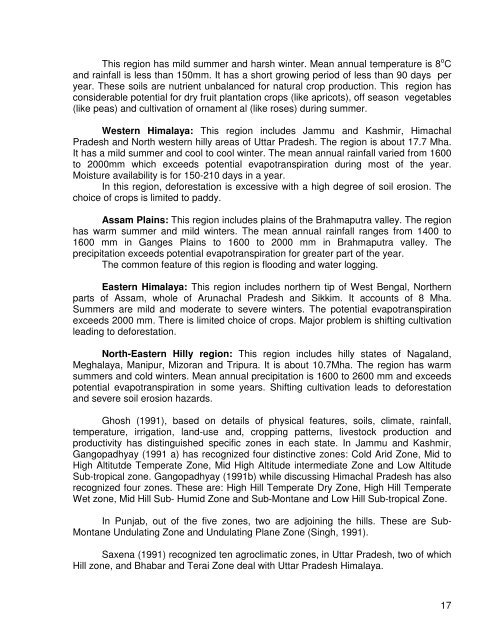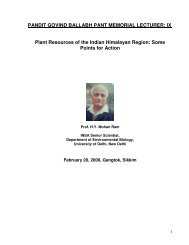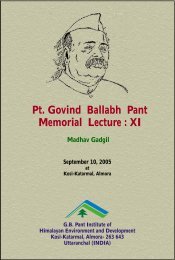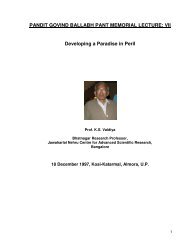Pandit Govind Ballabh Pant Memorial Lecture: II
Pandit Govind Ballabh Pant Memorial Lecture: II
Pandit Govind Ballabh Pant Memorial Lecture: II
You also want an ePaper? Increase the reach of your titles
YUMPU automatically turns print PDFs into web optimized ePapers that Google loves.
This region has mild summer and harsh winter. Mean annual temperature is 8 o C<br />
and rainfall is less than 150mm. It has a short growing period of less than 90 days per<br />
year. These soils are nutrient unbalanced for natural crop production. This region has<br />
considerable potential for dry fruit plantation crops (like apricots), off season vegetables<br />
(like peas) and cultivation of ornament al (like roses) during summer.<br />
Western Himalaya: This region includes Jammu and Kashmir, Himachal<br />
Pradesh and North western hilly areas of Uttar Pradesh. The region is about 17.7 Mha.<br />
It has a mild summer and cool to cool winter. The mean annual rainfall varied from 1600<br />
to 2000mm which exceeds potential evapotranspiration during most of the year.<br />
Moisture availability is for 150-210 days in a year.<br />
In this region, deforestation is excessive with a high degree of soil erosion. The<br />
choice of crops is limited to paddy.<br />
Assam Plains: This region includes plains of the Brahmaputra valley. The region<br />
has warm summer and mild winters. The mean annual rainfall ranges from 1400 to<br />
1600 mm in Ganges Plains to 1600 to 2000 mm in Brahmaputra valley. The<br />
precipitation exceeds potential evapotranspiration for greater part of the year.<br />
The common feature of this region is flooding and water logging.<br />
Eastern Himalaya: This region includes northern tip of West Bengal, Northern<br />
parts of Assam, whole of Arunachal Pradesh and Sikkim. It accounts of 8 Mha.<br />
Summers are mild and moderate to severe winters. The potential evapotranspiration<br />
exceeds 2000 mm. There is limited choice of crops. Major problem is shifting cultivation<br />
leading to deforestation.<br />
North-Eastern Hilly region: This region includes hilly states of Nagaland,<br />
Meghalaya, Manipur, Mizoran and Tripura. It is about 10.7Mha. The region has warm<br />
summers and cold winters. Mean annual precipitation is 1600 to 2600 mm and exceeds<br />
potential evapotranspiration in some years. Shifting cultivation leads to deforestation<br />
and severe soil erosion hazards.<br />
Ghosh (1991), based on details of physical features, soils, climate, rainfall,<br />
temperature, irrigation, land-use and, cropping patterns, livestock production and<br />
productivity has distinguished specific zones in each state. In Jammu and Kashmir,<br />
Gangopadhyay (1991 a) has recognized four distinctive zones: Cold Arid Zone, Mid to<br />
High Altitutde Temperate Zone, Mid High Altitude intermediate Zone and Low Altitude<br />
Sub-tropical zone. Gangopadhyay (1991b) while discussing Himachal Pradesh has also<br />
recognized four zones. These are: High Hill Temperate Dry Zone, High Hill Temperate<br />
Wet zone, Mid Hill Sub- Humid Zone and Sub-Montane and Low Hill Sub-tropical Zone.<br />
In Punjab, out of the five zones, two are adjoining the hills. These are Sub-<br />
Montane Undulating Zone and Undulating Plane Zone (Singh, 1991).<br />
Saxena (1991) recognized ten agroclimatic zones, in Uttar Pradesh, two of which<br />
Hill zone, and Bhabar and Terai Zone deal with Uttar Pradesh Himalaya.<br />
17











